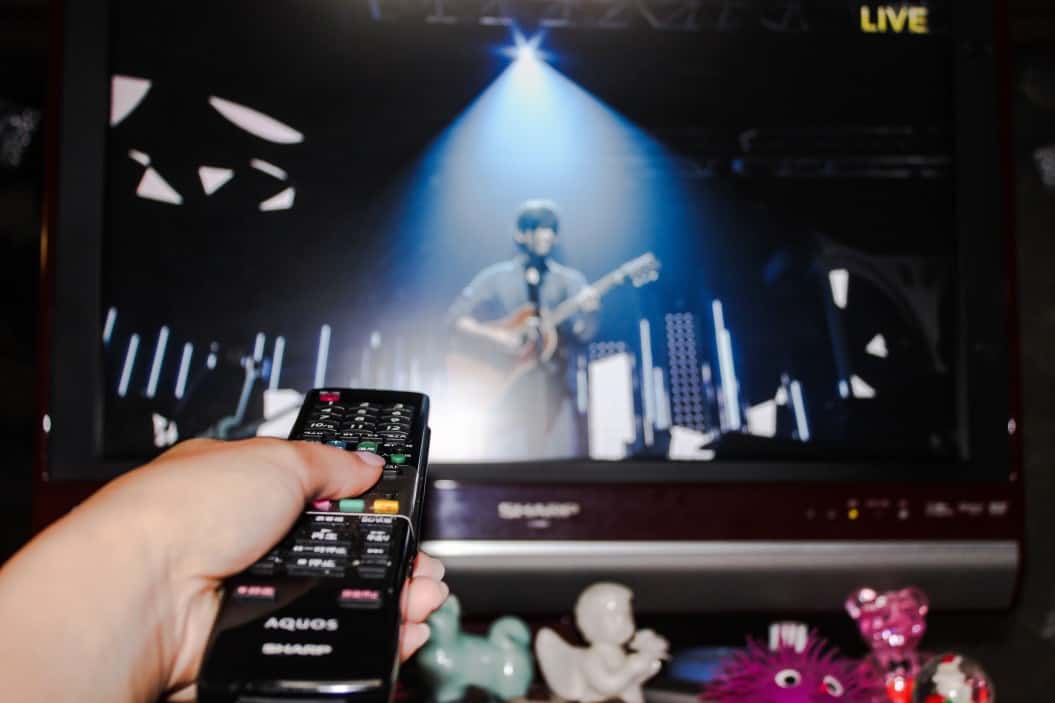Sometimes, you need to consider other criteria than just at-home viewing uses to find the best TV. So, let’s step into the world of business and compare a conference room TV vs a projector. And if internet connectivity is something you need, we have a great article that compares smart TVs and Android TVs.
KEY TAKEAWAYS:
- Projectors are both optimal and cost-efficient for displaying content on a large scale.
- Televisions are more durable and require less maintenance than projectors, but can be very expensive when purchasing display sizes above 85 inches.
- The deciding factor between either display format will be the desired screen size and cost.
Differences Between a Conference Room Projector vs a TV
When choosing an office display, it is easy to get caught up in the projector vs TV debate. Commercial projectors can be handy, are easily stored, and are great for casting larger images. However, TVs have better image quality and can be used for more diverse purposes, such as digital signage.
Insider Tip
If you require a large image, projectors will be much more affordable than larger television options. If not, television can be just as cheap and often provides a better image quality.
Below, we’ll go further into the details of each specific conference room technology and try to get you closer to having the best modern solution for your office. And if you’re looking into older display technology, you can check out our article that compares CRT vs LCD TVs.
Consider the Available Space
When deciding on visual solutions for office space, the most crucial factor is how much room you’ll need or have available for a screen. A quick way to decide what good screen size is for the room you want to put it in is to take the furthest viewing distance and divide it by 1.6.
Once you’ve accomplished this, and find that you’ll need at least 100 inches of display space, it would be wise to consider going with a projector.
Many modern projectors can adjust clearly to up to 300 inches. Unfortunately, TVs are hard to find for larger displays.
Image Quality
Typically, TVs with a screen size that’s closer to 60 inches will have a more impressive image quality. They also differ in how they perform in bright light. Laser projectors often can’t handle a high level of ambient light as a television screen can. So if there are windows in the room, you need to have some way of controlling the light levels.
However, when it comes to image production, projectors have adjustable display sizes, which can be helpful in a conference room setting.
Sound Quality
TVs also have better sound quality, and many laser projectors don’t come with built-in speakers. However, even if the projector does come with audio, the speakers will usually be of poor quality. Therefore, it will often be better to buy a separate sound system.
Lifespan and Durability
Televisions are much easier to set up and leave as-is for a long time. However, projectors need frequent attention. For example, you’ll need to change their bulbs regularly, and they are prone to more mechanical mishaps.
Warning
If you believe that at any point you will need a display above 100 inches, it might be better to go with a projector.
F.A.Q.S
What’s the ideal size of TV for your conference room?
IT experts say that, for business purposes, it is proper for a screen’s diagonal size to be half the length of the room.
Is a projector or a TV better for the eyes?
Projectors are better because they produce larger images which cause less eye strain.
How far should you sit from a 65 inch TV?
It’s recommended that viewers sit about 4 feet away from a 65-inch display.
STAT: Most business meetings are attended by eight or fewer people. (source)
REFERENCES:
- https://www.goubiq.com/conference-room-tvs-vs-projector-screens/
- https://smartway2.com/blog/whats-the-ideal-size-of-tv-for-your-conference-room/#:~:text=IT%20support%20specialist%20company%20Jones,the%20length%20of%20your%20room.
- https://pointerclicker.com/conference-room-projector-vs-tv/r
- https://www.nashua.co.za/blog/conference-tvs-vs-projector-screens-which-one-is-right-for-your-business/
- https://level3av.com/company/blog/item/torn-between-a-video-wall-vs-projector-for-the-conference-room-here-s-our-hot-take

































![Best Drones Under the Cost of Ferrari in [year] 25 Best Drones Under the Cost of Ferrari in 2026](https://www.gadgetreview.dev/wp-content/uploads/image-test-3.jpg)
![Best LEDs & LCDs in [year] ([month] Reviews) 26 Best LEDs & LCDs in 2026 (January Reviews)](https://www.gadgetreview.dev/wp-content/uploads/Samsung-UN65RU7100FXZA.jpg)
![Best Streaming Services in [year] ([month] Reviews) 27 Best Streaming Services in 2026 (January Reviews)](https://www.gadgetreview.dev/wp-content/uploads/netflix-750x422-1.png)
![Best Streaming Movie and Shows in [year] ([month] Reviews) 28 Best Streaming Movie and Shows in 2026 (January Reviews)](https://www.gadgetreview.dev/wp-content/uploads/Streaming-reviews.jpg)
![Best TVs in [year] ([month] Reviews) 29 Best TVs in 2026 (January Reviews)](https://www.gadgetreview.dev/wp-content/uploads/Sony-XBR55X810C-TV-1.jpg)
![Best Shows on Amazon in [year] ([month] Reviews) 30 Best Shows on Amazon in 2026 (January Reviews)](https://www.gadgetreview.dev/wp-content/uploads/The-Boys-750x474-1.jpg)
![Best Small TVs in [year] 31 Best Small TVs in 2026](https://www.gadgetreview.dev/wp-content/uploads/best-small-tv-image.jpg)
![Best 60 Inch TVs in [year] 32 Best 60 Inch TVs in 2026](https://www.gadgetreview.dev/wp-content/uploads/best-60-inch-tv-image.jpg)
![Best 50 Inch TVs in [year] 33 Best 50 Inch TVs in 2026](https://www.gadgetreview.dev/wp-content/uploads/best-50-inch-tv-imgr.jpg)
![Most Energy Efficient TVs in [year] 34 Most Energy Efficient TVs in 2026](https://www.gadgetreview.dev/wp-content/uploads/most-energy-efficient-tv-image.jpg)
![Best TVs for Apple TV in [year] 35 Best TVs for Apple TV in 2026](https://www.gadgetreview.dev/wp-content/uploads/best-tv-for-apple-tv-image.jpg)
![Best TV Antennas in [year] ([month] Reviews) 36 Best TV Antennas in 2026 (January Reviews)](https://www.gadgetreview.dev/wp-content/uploads/best-tv-antennas-image.jpg)
![Best Mitsubishi TVs in [year] 37 Best Mitsubishi TVs in 2026](https://www.gadgetreview.dev/wp-content/uploads/best-mitsubishi-tv-image.jpg)
![Best Smart TVs in [year] ([month] Reviews) 38 Best Smart TVs in 2026 (January Reviews)](https://www.gadgetreview.dev/wp-content/uploads/best-smart-tvs-image.jpg)
![Best Conference Room TVs in [year] 39 Best Conference Room TVs in 2026](https://www.gadgetreview.dev/wp-content/uploads/best-conference-room-tv-image.jpg)
![Best Dumb TVs in [year] 40 Best Dumb TVs in 2026](https://www.gadgetreview.dev/wp-content/uploads/best-dumb-tv-image.jpg)
![Best 80 inch TVs in [year] 41 Best 80 inch TVs in 2026](https://www.gadgetreview.dev/wp-content/uploads/best-80-inch-tv-image.jpg)
![Best Shows on Hulu in [year] ([month] Reviews) 42 Best Shows on Hulu in 2026 (January Reviews)](https://www.gadgetreview.dev/wp-content/uploads/The-Handmaids-Tale-750x422-1.jpg)

















